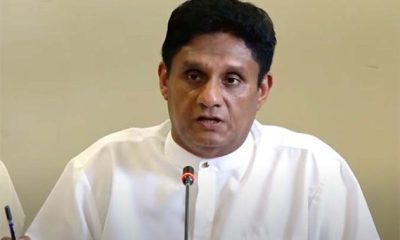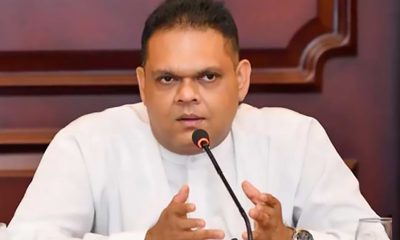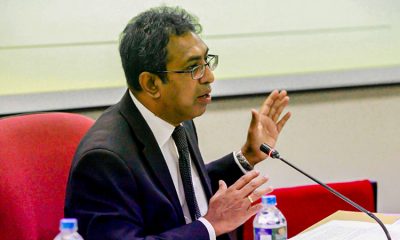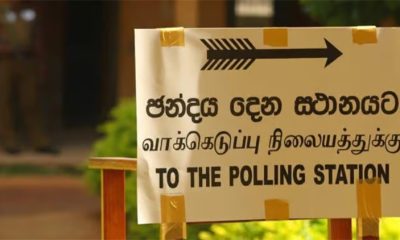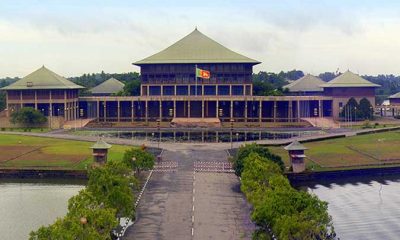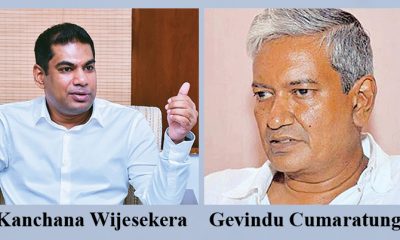Features
Five second escape for Prez and PM

August 1987 parliament grenade attack
By Nihal Seneviratne
President J.R. Jayewardene had only a few days before, on July 29, 1987, signed the very controversial Indo- Sri Lanka Pact with Prime Minister Rajiv Gandhi of India. Most observers take the view that Jayewardene fighting a JVP insurrection in the South and a LTTE insurgency in the North had little option but to sign this agreement very much loaded on Indian terms.
The LTTE were determined to win a separate state of Eelam for the Tamil people even at the expense of a long, ferocious, war by spurning all Government efforts at coming to a peaceful solution offered to them. The JVP’s second insurgency had created a near anarchy in the South. There was no possibility of engaging in war on two fronts and Jayewardene signed the agreement which brought the IPKF here.
In signing this agreement, JRJ had not consulted his Prime Minister or his Cabinet colleagues. Possibly only Minister Gamini Dissanayake knew about it. After signing the agreement at Republic Square that day, Prime Minister Rajiv Gandhi was accorded a guard of honour. A naval rating who was part of the guard of honour assembled opposite President’s House, struck a heavy blow on Gandhi’s shoulder with the butt of his gun.
Very fortunately the PM was not seriously hurt but possibly suffered only a few bruises. Immediately his own Indian security and Sri Lankan naval security pushed the Indian PM forward to escape the severity of the blow and took the naval rating into custody. This single incident captured headlines all over the world. If the blow ended in the death of the Indian Prime Minister, the consequences would have been even too terrible to comprehend.
It was just two days later that President Jayewardene was due to attend a session of Parliament as he wished before that to address his own UNP Parliamentary Group in Committee Room 1 to explain to the Members why he signed the Agreement. Parliament was scheduled to sit the same afternoon for its regular business – President Jayewardene had arrived at the Parliamentary premises that morning around 9 a.m. and was due at Committee Room 1, the longest committee room in Parliament with a seating capacity of almost 150.
But since it was the Head of State and Government summoning me, I felt obliged to go. Both President Jayewardene and Prime Minister Premadasa were seated at the polished table with Premadasa on the President’s right and Chief Government Whip Vincent Perera on his left. In front over 100 Govt Ministers and MPs were seated facing the President, PM and Chief Government Whip.
When I went to the committee room and bent down to hear the seated president, he asked me what business was due to be taken up that afternoon. Very fortunately I had taken along the Order Paper for the day and together we went through the 25 items of Government business listed on it. Once this was over I went back to my office on the second floor of the building.
Not even half an hour later, my peon rushed into my room saying excitedly, “Sir, the Prime Minister is calling for you.” In blissful ignorance of what was in store I rushed to the ground floor. At the very entrance to the lift I met Prime Minster Premadasa with his national dress partially raised, excitedly exclaiming to me, “Nihal a bomb has exploded in the Committee Room. Search the room and have the Police surround the building.”
As I rushed into the Committee Room, I saw President Jayewardene being hurriedly escorted out of the room and building to a vehicle parked outside the Members’ entrance. When I went to the Committee Room, it was in complete shambles with the room full of smoke and splintered glass from the doors and shrapnel all over the place.
Some members were lying prostrate on the floor trying to protect themselves. I then saw Minister Lalith Athulathmudali on a stretcher, bleeding very heavily and being rushed to an ambulance which I had arranged to be at the Members’ entrance. He was rushed immediately to the Sri Jayewardenepura Hospital through the back entrance of Parliament. For security reasons this gate was closed but we kept it open on sitting days as it was only a mile away from the Sri Jayewardenapura Hospital.
Very sadly, the only casualty that day was Mr. Keerthi Abeywickreme, MP for Akmeemana, who had been hit by shrapnel on his temple. His widow later told me that she had asked him to be careful, but he had replied that he was only going to Parliament which was safe and for her not to be worried.
As at that time I did not know how the explosion had occurred. I immediately rang my University colleague, Frank de Silva, IGP, and asked him to come immediately and to provide adequate security by surrounding the precincts of Parliament to prevent anyone from leaving. I then ordered the Parliament Sergeant-of-Arms and police to ensure that no MP. staff member or visitor be allowed to leave the building.
At that time an MP told me that someone had thrown the bomb from a backdoor of the committee room and said all he saw was a hand with long white sleeves throwing something at the head table. Immediately I ordered the 950 parliament staff on duty that day not to leave the building. Even after the police contingent arrived, no one was sure whether it was a bomb and how it exploded or whether it was some other missile.
I, for one, then began speculating whether it could be one of my own 950 staff or whether it was even a member of the president’s staff who had accompanied him. We did not know whom to suspect. The IGP in his conversation with me mentioned that it may have been a gunshot from a pistol and then asked me to get everyone on duty that day to have both their hands checked for possible traces of gun powder.
A search for a weapon was then undertaken by the Police. Everyone’s hands were scanned for gunpowder and no one was allowed to leave the building. It was past 9 p.m. when the meticulous checking was over. A few MPs then told me that all they saw was this hand clothed in a white sleeve throwing something onto the polished table at which the President and Prime Minister sat. It was almost midnight when I left the building.
The very next morning I asked the Sergeant-at-Arms to check whether all the staff had returned to work. All were present except for four. One was in hospital, two were on approved leave but one was missing and that was Ajith Kumara, a sweeper I had recruited. Police searched his house around Kadawatha and found it closed. Neighbours then had told the Police that the chief occupant had left the house at night taking his family with him.
So all suspicion then centered around him and Police started a nationwide search. After a few days we were able to pull the pieces of the puzzle together. It transpired that Ajith Kumara had come that morning with a hand grenade hidden in his shoe. The police at the entrance had missed it. The President’s security staff had checked all the rooms and doors leading to the committee room and locked it up.
It then transpired that Ajith Kumara, using a false key he had made, had opened the room and hidden behind a big painting standing on the ground. He had then opened the door leading to committee room and flung the hand grenade aiming at the president. The grenade ricocheted off the polished table at which the three VIPs sat and rolled under the chair Lalith Athulathmudali was sitting on in the front row of seats.
It had then exploded blasting a large hole on the ground and severely injuring Lalith’s entire back. When he was recovering at the Sri Jayewardenpura Hospital I called on him and chatted for a while. He was full of praise for Dr. K. Yoheswaran, an eminent surgeon who operated on him, saving his life. He told me he had particularly wanted Dr Yoheswaran to undertake the complicated surgery which was done so successfully.
Later on, after Lalith recovered, he walked into my room and discussed the incident with me. He told me that Ajith Kumara had made the fundamental mistake of hurling the grenade after the pin was released. With Lalith’s deep knowledge of such matters and arms, he said that after the pin is pulled, one has to count, one thousand, two thousand, three thousand and then throw the grenade. If this had been done, the grenade would have exploded on the polished table surface and all the VIPs would not have survived.
So the President, Prime Minister and Chief Whip escaped instant death by just five seconds. Instead the grenade ricocheted off the polished table and injured Lalith very badly. Six months had passed by and the Police was still looking for one of the most wanted men in Sri Lanka for nearly assassinating the President and Prime Minister.
It so happened that the police in the Kegalle district had come to a paddy field searching for those distilling kasippu, a local brew. Ajith Kumara had been in a village shed and on seeing a police team, had fled. The Police, seeing a person fleeing, gave chase and arrested him. All that time, they did not know at all that they had caught the most wanted fugitive from justice.
When the police contacted me, I was able to confirm that the person caught was none other than Ajith Kumara himself. A week later, the suspect was brought under heavy security to Parliament. He had then confessed to his crime and explained in detail how he had brought the grenade in his shoe – and how he had hidden behind the painting. After the Presidential Security had checked that very room, used a false key he had had made to surreptitiously enter the room. He confessed to throwing the hand grenade.
Two days later, Speaker E.L.Senanayake and I were summoned to appear before Cabinet. The Speaker very diplomatically refused to go saying that it was incorrect for him to appear before Cabinet. That left me with no option but to go before the Cabinet myself. I nervously walked in since I had never before been summoned like this feeling like the Christian being thrown to the wolves in Roman times.
I knew the ministers would cross-examine me on how I recruited Ajith Kumara, so judiciously I went with a Police CID report which had cleared him and allowed his recruitment. Armed with the file I sat before the entire Cabinet. Minister Montague Jayawickreme pounced on me asking how I recruited him and I politely showed the clearance file issued by the CID. Many other questions were fired at me which I politely answered.
I was then allowed to leave. It later transpired that after the clearance report had been issued by the Police, the JVP had secretly recruited him as they found in him the ideal person to carry out the mission of assassinating the president and prime minister since he was already working in Parliament and had access.
A few days later I had a request from Mrs Jayewardene to see the room in which her husband escaped assassination by seconds. She was accompanied by two grandchildren, Ravi’s two sons. They inspected the polished table from which the grenade had bounced. I was very moved by her presence and the gracious lady moved on without making any comment.
This saga has had a strange ending. When Ajith Kumara was produced as an accused before court, his counsel took up the defence that the police relied only on his confession and he was acquitted. Regrettably the Attorney General’s Department had mishandled the prosecution and the Judge acquitted Ajith Kumara who left the court a free man.
History will record how a President and Prime Minister escaped death by a few mere seconds.
(The writer is a retired Secretary General of Parliament)
Features
The heart-friendly health minister

by Dr Gotabhya Ranasinghe
Senior Consultant Cardiologist
National Hospital Sri Lanka
When we sought a meeting with Hon Dr. Ramesh Pathirana, Minister of Health, he graciously cleared his busy schedule to accommodate us. Renowned for his attentive listening and deep understanding, Minister Pathirana is dedicated to advancing the health sector. His openness and transparency exemplify the qualities of an exemplary politician and minister.
Dr. Palitha Mahipala, the current Health Secretary, demonstrates both commendable enthusiasm and unwavering support. This combination of attributes makes him a highly compatible colleague for the esteemed Minister of Health.
Our discussion centered on a project that has been in the works for the past 30 years, one that no other minister had managed to advance.
Minister Pathirana, however, recognized the project’s significance and its potential to revolutionize care for heart patients.
The project involves the construction of a state-of-the-art facility at the premises of the National Hospital Colombo. The project’s location within the premises of the National Hospital underscores its importance and relevance to the healthcare infrastructure of the nation.
This facility will include a cardiology building and a tertiary care center, equipped with the latest technology to handle and treat all types of heart-related conditions and surgeries.
Securing funding was a major milestone for this initiative. Minister Pathirana successfully obtained approval for a $40 billion loan from the Asian Development Bank. With the funding in place, the foundation stone is scheduled to be laid in September this year, and construction will begin in January 2025.
This project guarantees a consistent and uninterrupted supply of stents and related medications for heart patients. As a result, patients will have timely access to essential medical supplies during their treatment and recovery. By securing these critical resources, the project aims to enhance patient outcomes, minimize treatment delays, and maintain the highest standards of cardiac care.
Upon its fruition, this monumental building will serve as a beacon of hope and healing, symbolizing the unwavering dedication to improving patient outcomes and fostering a healthier society.We anticipate a future marked by significant progress and positive outcomes in Sri Lanka’s cardiovascular treatment landscape within the foreseeable timeframe.
Features
A LOVING TRIBUTE TO JESUIT FR. ALOYSIUS PIERIS ON HIS 90th BIRTHDAY

by Fr. Emmanuel Fernando, OMI
Jesuit Fr. Aloysius Pieris (affectionately called Fr. Aloy) celebrated his 90th birthday on April 9, 2024 and I, as the editor of our Oblate Journal, THE MISSIONARY OBLATE had gone to press by that time. Immediately I decided to publish an article, appreciating the untiring selfless services he continues to offer for inter-Faith dialogue, the renewal of the Catholic Church, his concern for the poor and the suffering Sri Lankan masses and to me, the present writer.
It was in 1988, when I was appointed Director of the Oblate Scholastics at Ampitiya by the then Oblate Provincial Fr. Anselm Silva, that I came to know Fr. Aloy more closely. Knowing well his expertise in matters spiritual, theological, Indological and pastoral, and with the collaborative spirit of my companion-formators, our Oblate Scholastics were sent to Tulana, the Research and Encounter Centre, Kelaniya, of which he is the Founder-Director, for ‘exposure-programmes’ on matters spiritual, biblical, theological and pastoral. Some of these dimensions according to my view and that of my companion-formators, were not available at the National Seminary, Ampitiya.
Ever since that time, our Oblate formators/ accompaniers at the Oblate Scholasticate, Ampitiya , have continued to send our Oblate Scholastics to Tulana Centre for deepening their insights and convictions regarding matters needed to serve the people in today’s context. Fr. Aloy also had tried very enthusiastically with the Oblate team headed by Frs. Oswald Firth and Clement Waidyasekara to begin a Theologate, directed by the Religious Congregations in Sri Lanka, for the contextual formation/ accompaniment of their members. It should very well be a desired goal of the Leaders / Provincials of the Religious Congregations.
Besides being a formator/accompanier at the Oblate Scholasticate, I was entrusted also with the task of editing and publishing our Oblate journal, ‘The Missionary Oblate’. To maintain the quality of the journal I continue to depend on Fr. Aloy for his thought-provoking and stimulating articles on Biblical Spirituality, Biblical Theology and Ecclesiology. I am very grateful to him for his generous assistance. Of late, his writings on renewal of the Church, initiated by Pope St. John XX111 and continued by Pope Francis through the Synodal path, published in our Oblate journal, enable our readers to focus their attention also on the needed renewal in the Catholic Church in Sri Lanka. Fr. Aloy appreciated very much the Synodal path adopted by the Jesuit Pope Francis for the renewal of the Church, rooted very much on prayerful discernment. In my Religious and presbyteral life, Fr.Aloy continues to be my spiritual animator / guide and ongoing formator / acccompanier.
Fr. Aloysius Pieris, BA Hons (Lond), LPh (SHC, India), STL (PFT, Naples), PhD (SLU/VC), ThD (Tilburg), D.Ltt (KU), has been one of the eminent Asian theologians well recognized internationally and one who has lectured and held visiting chairs in many universities both in the West and in the East. Many members of Religious Congregations from Asian countries have benefited from his lectures and guidance in the East Asian Pastoral Institute (EAPI) in Manila, Philippines. He had been a Theologian consulted by the Federation of Asian Bishops’ Conferences for many years. During his professorship at the Gregorian University in Rome, he was called to be a member of a special group of advisers on other religions consulted by Pope Paul VI.
Fr. Aloy is the author of more than 30 books and well over 500 Research Papers. Some of his books and articles have been translated and published in several countries. Among those books, one can find the following: 1) The Genesis of an Asian Theology of Liberation (An Autobiographical Excursus on the Art of Theologising in Asia, 2) An Asian Theology of Liberation, 3) Providential Timeliness of Vatican 11 (a long-overdue halt to a scandalous millennium, 4) Give Vatican 11 a chance, 5) Leadership in the Church, 6) Relishing our faith in working for justice (Themes for study and discussion), 7) A Message meant mainly, not exclusively for Jesuits (Background information necessary for helping Francis renew the Church), 8) Lent in Lanka (Reflections and Resolutions, 9) Love meets wisdom (A Christian Experience of Buddhism, 10) Fire and Water 11) God’s Reign for God’s poor, 12) Our Unhiddden Agenda (How we Jesuits work, pray and form our men). He is also the Editor of two journals, Vagdevi, Journal of Religious Reflection and Dialogue, New Series.
Fr. Aloy has a BA in Pali and Sanskrit from the University of London and a Ph.D in Buddhist Philosophy from the University of Sri Lankan, Vidyodaya Campus. On Nov. 23, 2019, he was awarded the prestigious honorary Doctorate of Literature (D.Litt) by the Chancellor of the University of Kelaniya, the Most Venerable Welamitiyawe Dharmakirthi Sri Kusala Dhamma Thera.
Fr. Aloy continues to be a promoter of Gospel values and virtues. Justice as a constitutive dimension of love and social concern for the downtrodden masses are very much noted in his life and work. He had very much appreciated the commitment of the late Fr. Joseph (Joe) Fernando, the National Director of the Social and Economic Centre (SEDEC) for the poor.
In Sri Lanka, a few religious Congregations – the Good Shepherd Sisters, the Christian Brothers, the Marist Brothers and the Oblates – have invited him to animate their members especially during their Provincial Congresses, Chapters and International Conferences. The mainline Christian Churches also have sought his advice and followed his seminars. I, for one, regret very much, that the Sri Lankan authorities of the Catholic Church –today’s Hierarchy—- have not sought Fr.
Aloy’s expertise for the renewal of the Catholic Church in Sri Lanka and thus have not benefited from the immense store of wisdom and insight that he can offer to our local Church while the Sri Lankan bishops who governed the Catholic church in the immediate aftermath of the Second Vatican Council (Edmund Fernando OMI, Anthony de Saram, Leo Nanayakkara OSB, Frank Marcus Fernando, Paul Perera,) visited him and consulted him on many matters. Among the Tamil Bishops, Bishop Rayappu Joseph was keeping close contact with him and Bishop J. Deogupillai hosted him and his team visiting him after the horrible Black July massacre of Tamils.
Features
A fairy tale, success or debacle

Sri Lanka-Singapore Free Trade Agreement
By Gomi Senadhira
senadhiragomi@gmail.com
“You might tell fairy tales, but the progress of a country cannot be achieved through such narratives. A country cannot be developed by making false promises. The country moved backward because of the electoral promises made by political parties throughout time. We have witnessed that the ultimate result of this is the country becoming bankrupt. Unfortunately, many segments of the population have not come to realize this yet.” – President Ranil Wickremesinghe, 2024 Budget speech
Any Sri Lankan would agree with the above words of President Wickremesinghe on the false promises our politicians and officials make and the fairy tales they narrate which bankrupted this country. So, to understand this, let’s look at one such fairy tale with lots of false promises; Ranil Wickremesinghe’s greatest achievement in the area of international trade and investment promotion during the Yahapalana period, Sri Lanka-Singapore Free Trade Agreement (SLSFTA).
It is appropriate and timely to do it now as Finance Minister Wickremesinghe has just presented to parliament a bill on the National Policy on Economic Transformation which includes the establishment of an Office for International Trade and the Sri Lanka Institute of Economics and International Trade.
Was SLSFTA a “Cleverly negotiated Free Trade Agreement” as stated by the (former) Minister of Development Strategies and International Trade Malik Samarawickrama during the Parliamentary Debate on the SLSFTA in July 2018, or a colossal blunder covered up with lies, false promises, and fairy tales? After SLSFTA was signed there were a number of fairy tales published on this agreement by the Ministry of Development Strategies and International, Institute of Policy Studies, and others.
However, for this article, I would like to limit my comments to the speech by Minister Samarawickrama during the Parliamentary Debate, and the two most important areas in the agreement which were covered up with lies, fairy tales, and false promises, namely: revenue loss for Sri Lanka and Investment from Singapore. On the other important area, “Waste products dumping” I do not want to comment here as I have written extensively on the issue.
1. The revenue loss
During the Parliamentary Debate in July 2018, Minister Samarawickrama stated “…. let me reiterate that this FTA with Singapore has been very cleverly negotiated by us…. The liberalisation programme under this FTA has been carefully designed to have the least impact on domestic industry and revenue collection. We have included all revenue sensitive items in the negative list of items which will not be subject to removal of tariff. Therefore, 97.8% revenue from Customs duty is protected. Our tariff liberalisation will take place over a period of 12-15 years! In fact, the revenue earned through tariffs on goods imported from Singapore last year was Rs. 35 billion.
The revenue loss for over the next 15 years due to the FTA is only Rs. 733 million– which when annualised, on average, is just Rs. 51 million. That is just 0.14% per year! So anyone who claims the Singapore FTA causes revenue loss to the Government cannot do basic arithmetic! Mr. Speaker, in conclusion, I call on my fellow members of this House – don’t mislead the public with baseless criticism that is not grounded in facts. Don’t look at petty politics and use these issues for your own political survival.”
I was surprised to read the minister’s speech because an article published in January 2018 in “The Straits Times“, based on information released by the Singaporean Negotiators stated, “…. With the FTA, tariff savings for Singapore exports are estimated to hit $10 million annually“.
As the annual tariff savings (that is the revenue loss for Sri Lanka) calculated by the Singaporean Negotiators, Singaporean $ 10 million (Sri Lankan rupees 1,200 million in 2018) was way above the rupees’ 733 million revenue loss for 15 years estimated by the Sri Lankan negotiators, it was clear to any observer that one of the parties to the agreement had not done the basic arithmetic!
Six years later, according to a report published by “The Morning” newspaper, speaking at the Committee on Public Finance (COPF) on 7th May 2024, Mr Samarawickrama’s chief trade negotiator K.J. Weerasinghehad had admitted “…. that forecasted revenue loss for the Government of Sri Lanka through the Singapore FTA is Rs. 450 million in 2023 and Rs. 1.3 billion in 2024.”
If these numbers are correct, as tariff liberalisation under the SLSFTA has just started, we will pass Rs 2 billion very soon. Then, the question is how Sri Lanka’s trade negotiators made such a colossal blunder. Didn’t they do their basic arithmetic? If they didn’t know how to do basic arithmetic they should have at least done their basic readings. For example, the headline of the article published in The Straits Times in January 2018 was “Singapore, Sri Lanka sign FTA, annual savings of $10m expected”.
Anyway, as Sri Lanka’s chief negotiator reiterated at the COPF meeting that “…. since 99% of the tariffs in Singapore have zero rates of duty, Sri Lanka has agreed on 80% tariff liberalisation over a period of 15 years while expecting Singapore investments to address the imbalance in trade,” let’s turn towards investment.
Investment from Singapore
In July 2018, speaking during the Parliamentary Debate on the FTA this is what Minister Malik Samarawickrama stated on investment from Singapore, “Already, thanks to this FTA, in just the past two-and-a-half months since the agreement came into effect we have received a proposal from Singapore for investment amounting to $ 14.8 billion in an oil refinery for export of petroleum products. In addition, we have proposals for a steel manufacturing plant for exports ($ 1 billion investment), flour milling plant ($ 50 million), sugar refinery ($ 200 million). This adds up to more than $ 16.05 billion in the pipeline on these projects alone.
And all of these projects will create thousands of more jobs for our people. In principle approval has already been granted by the BOI and the investors are awaiting the release of land the environmental approvals to commence the project.
I request the Opposition and those with vested interests to change their narrow-minded thinking and join us to develop our country. We must always look at what is best for the whole community, not just the few who may oppose. We owe it to our people to courageously take decisions that will change their lives for the better.”
According to the media report I quoted earlier, speaking at the Committee on Public Finance (COPF) Chief Negotiator Weerasinghe has admitted that Sri Lanka was not happy with overall Singapore investments that have come in the past few years in return for the trade liberalisation under the Singapore-Sri Lanka Free Trade Agreement. He has added that between 2021 and 2023 the total investment from Singapore had been around $162 million!
What happened to those projects worth $16 billion negotiated, thanks to the SLSFTA, in just the two-and-a-half months after the agreement came into effect and approved by the BOI? I do not know about the steel manufacturing plant for exports ($ 1 billion investment), flour milling plant ($ 50 million) and sugar refinery ($ 200 million).
However, story of the multibillion-dollar investment in the Petroleum Refinery unfolded in a manner that would qualify it as the best fairy tale with false promises presented by our politicians and the officials, prior to 2019 elections.
Though many Sri Lankans got to know, through the media which repeatedly highlighted a plethora of issues surrounding the project and the questionable credentials of the Singaporean investor, the construction work on the Mirrijiwela Oil Refinery along with the cement factory began on the24th of March 2019 with a bang and Minister Ranil Wickremesinghe and his ministers along with the foreign and local dignitaries laid the foundation stones.
That was few months before the 2019 Presidential elections. Inaugurating the construction work Prime Minister Ranil Wickremesinghe said the projects will create thousands of job opportunities in the area and surrounding districts.
The oil refinery, which was to be built over 200 acres of land, with the capacity to refine 200,000 barrels of crude oil per day, was to generate US$7 billion of exports and create 1,500 direct and 3,000 indirect jobs. The construction of the refinery was to be completed in 44 months. Four years later, in August 2023 the Cabinet of Ministers approved the proposal presented by President Ranil Wickremesinghe to cancel the agreement with the investors of the refinery as the project has not been implemented! Can they explain to the country how much money was wasted to produce that fairy tale?
It is obvious that the President, ministers, and officials had made huge blunders and had deliberately misled the public and the parliament on the revenue loss and potential investment from SLSFTA with fairy tales and false promises.
As the president himself said, a country cannot be developed by making false promises or with fairy tales and these false promises and fairy tales had bankrupted the country. “Unfortunately, many segments of the population have not come to realize this yet”.
(The writer, a specialist and an activist on trade and development issues . )



